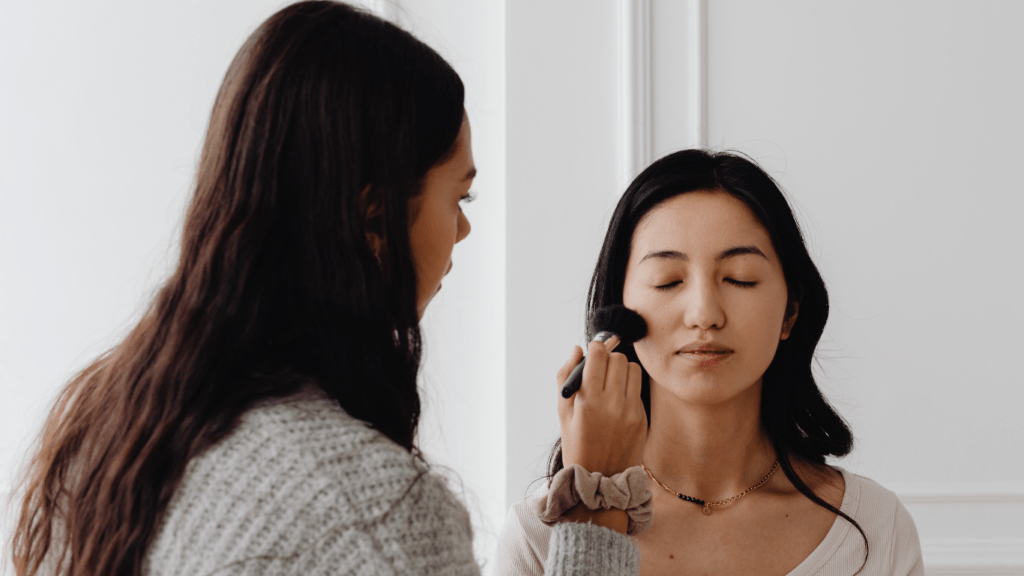Understanding Contouring and Highlighting
Contouring and highlighting are essential techniques to enhance your facial features, creating the illusion of depth and dimension. Mastering these methods can elevate your makeup game.
What Is Contouring?
Contouring uses makeup to define and shape facial structure. It involves applying a darker shade to areas you want to recede, such as the hollows of your cheeks, sides of your nose, and jawline. By sculpting shadows, you can create the appearance of a more defined bone structure.
What Is Highlighting?
Highlighting focuses on bringing certain features forward with lighter shades. Applied to high points like the tops of cheekbones, bridge of the nose, and cupid’s bow, highlighting attracts light to these areas. This technique adds brightness and a natural glow to the face.
- Enhanced Features: Helps to accentuate the best parts of your face.
- Facial Symmetry: Creates an illusion of a more symmetrical face.
- Customized Appearance: Allows you to modify facial dimensions to achieve desired looks.
- Photogenic Results: Ensures your features stand out in photos.
Essential Tools and Products
To achieve a flawless contour and highlight, you’ll need the right tools and products. Here’s a breakdown of essential items for each step.
Contouring Products
Contouring products create depth and definition. Powder and cream formulations cater to different preferences. Powders are ideal for oily skin and offer a natural finish. Brands like Anastasia Beverly Hills and NYX have well-known powder contour kits. Creams work best for dry skin, providing a smoother application. Fenty Beauty and Huda Beauty offer popular cream contour sticks. Choose products one to two shades darker than your natural skin tone for effective contouring.
Highlighting Products
Highlighting products bring forward and accentuate features. Powder and liquid formulations suit various types. Powder highlighters, like those from Becca or MAC, offer a subtle, buildable glow. Liquid highlighters, such as those by Benefit or NARS, give a dewy, radiant finish. Opt for shades that complement your skin tone; for example, champagne or gold tones suit medium to dark skin, while pearlescent or pink tones flatter fair to light skin. Highlighters add dimension to cheekbones, the bridge of the nose, and the cupid’s bow.
Brushes and Blenders
Quality brushes and blenders ensure seamless application. An angled contour brush, like those from Sigma or Morphe, fits perfectly along the cheekbones and jawline. A small, fluffy highlighter brush, such as one from Real Techniques, allows for precise placement of highlighter. Blending sponges, like the Beauty Blender or Real Techniques Miracle Complexion Sponge, help blend both cream and powder products smoothly. Regularly clean your brushes and sponges to maintain hygiene and performance.
A comprehensive set of contouring and highlighting tools and products can enhance your face’s natural structure when used correctly.
Step-by-Step Guide to Contouring

Mastering contouring requires following some essential steps. Here’s a detailed guide to help achieve a flawless look.
Preparing Your Skin
Start by cleansing and moisturizing your face. Well-prepped skin ensures even application. Use a primer to create a smooth base. This step helps makeup stay put throughout the day. It’s crucial to match the primer type with your skin type—mattifying for oily skin, hydrating for dry skin.
Mapping Out Contour Lines
Identify your face shape first, as this dictates contour placement. Apply a darker shade along the hairline, under the cheekbones, and along the jawline. For highlighting, use a lighter shade on the bridge of the nose, cheekbones, center of the forehead, and cupid’s bow. Use products formulated for contouring to avoid harsh lines. Anastasia Beverly Hills Contour Kit and Fenty Beauty Match Stix are excellent choices.
Blending Techniques
Use a damp beauty blender or a contour brush to blend shades seamlessly. Start from the outer edges of the contour lines and work inwards. Patting motions ensure a natural finish. Avoid dragging, which can cause streaks. Real Techniques and Sigma offer high-quality tools for this step. Blending well is key to achieving a natural, sculpted look.
By following these steps, I ensure a balanced and natural contour every time.
Step-by-Step Guide to Highlighting
Highlighting brings light and attention to specific areas of the face, enhancing the natural structure and creating a radiant look. Follow this guide to apply highlighter effectively.
Choosing the Right Highlighter
Select a highlighter that complements your skin tone. For fair skin, choose pearl or champagne shades. Medium skin tones benefit from gold or peach highlighters. Darker skin tones shine with bronze or copper shades. Cream, liquid, and powder highlighters are available; choose based on your skin type. Creams and liquids suit dry to normal skin, while powders suit oily skin.
Key Areas to Highlight
Focus on these areas:
- Cheekbones: Apply above the contour line to lift and accentuate the cheeks.
- Brow Bone: Highlight under the brows to open up the eyes.
- Nose: Lightly apply to the bridge for a defined look.
- Cupid’s Bow: Dab on the upper lip for a fuller appearance.
- Inner Corners of Eyes: Brighten the eyes by adding a touch here.
Blending and Setting
Blend the highlighter seamlessly into the skin using a damp makeup sponge or a specific blending brush. Ensure no harsh lines are visible. Set the highlighter with a light dusting of translucent powder if you have oily skin, or leave it as is for a natural glow. Use a setting spray to lock in the look and enhance longevity.
Common Mistakes to Avoid
Contouring and highlighting can dramatically enhance your makeup look, but avoid these common pitfalls.
Over-Contouring
Applying too much contour product can make your makeup appear unnatural and harsh. Use a light hand and build the product gradually. Opt for a contour color just two shades darker than your skin tone for a subtle definition. Heavy contouring can lead to cakey makeup, which is challenging to correct later.
Choosing the Wrong Shades
Selecting the wrong shades for contouring and highlighting can disrupt your entire look. For contouring, choose a matte shade that’s two shades darker than your skin tone. For highlighting, opt for a product that’s one to two shades lighter than your skin. Fair skin tones look good with champagne or pinkish hues, while medium to dark skin tones excel with golden or peachy highlighters. Incorrect shade choices can make your makeup look off and unflattering.
Not Blending Properly
Failing to blend contour and highlighter well can leave you with harsh lines and an uneven finish. Use a damp beauty blender or a soft brush for seamless integration. Blend the contours into your foundation, ensuring no sharp lines. For highlighting, blend until the product merges into your skin, giving a natural glow. Poor blending creates a patchy appearance that diminishes the overall effect.


 Creative Director at Divine Glamour Trail, is the visionary behind the platform, which is dedicated to bringing readers the latest trends in hairstyles, beauty, and skincare. With a passion for timeless fashion and expert style guidance, George provides tips, secrets, and updates that empower individuals to enhance their personal style. His platform is a go-to source for anyone looking to stay ahead in the fashion game, combining modern trends with timeless elegance to help readers feel confident and look their best.
Creative Director at Divine Glamour Trail, is the visionary behind the platform, which is dedicated to bringing readers the latest trends in hairstyles, beauty, and skincare. With a passion for timeless fashion and expert style guidance, George provides tips, secrets, and updates that empower individuals to enhance their personal style. His platform is a go-to source for anyone looking to stay ahead in the fashion game, combining modern trends with timeless elegance to help readers feel confident and look their best.
